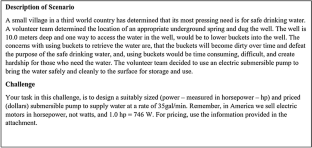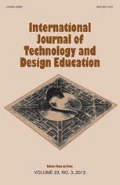Abstract
The research presented is of an investigation into the critical thinking (CT) and problem solving (PS) abilities used by high school technology and engineering (T/E) students when attempting to achieve a viable solution for an authentic engineering design-no-make challenge presented outside the context of the classroom in which their STEM content was first learned. Five key abilities were identified and assessed as indicators of a student’s ability to problem solving within the context of authentic engineering design. Findings from data analyses indicates T/E students who acquire STEM content through T/E design base learning demonstrate significantly better CT and PS abilities in designing an engineering solution compared with a hypothesized mean for students receiving their STEM content via traditional classroom instruction. Furthermore, student abilities associated with selecting and utilizing relevant science and math content and practices, and communicating logical reasoning in their design solution were found to be critical to successful problem solving.

Similar content being viewed by others
References
Atman, C. J., & Bursic, K. M. (1998). Verbal protocol analysis as a method to document engineering student design processes. Journal of Engineering Education, 87, 121–132.
Ball, J. L., & Christensen, B. T. (2019). Advancing an understanding of design cognition and design metacognition: Progress and prospects. Design Studies, 65, 35–59.
Barak, M., & Assal, M. (2018). Robotics and STEM learning: students’ achievements in assignments according to the P3 Task Taxonomy—practice, problem solving, and projects. International Journal of Technology and Design Education, 28, 121–144. https://doi.org/10.1007/s10798-016-9385-9.
Barak, M., & Assal, M. (2018). Robotics and STEM learning: Student achievements in assignments according to the P3 task taxonomy-practice, problem solving and projects. International Journal of Technology and Design Education, 28, 121–144. https://doi.org/10.1007/s10798-016-9385-9.
Barlex, D. (2003). Considering the impact of design and technology on society—The experience of the Young Foresight project. In J. R. Dakers & M. J. Devries (Eds.), The place of design and technology in the curriculum PATT conference 2003 (pp. 142–147). Glasgow: University of Glasgow.
Barlex, D. M., & Trebell, D. (2008). Design-without-make: Challenging the conventional approach to teaching and learning in a design and technology classroom. International Journal of Technology and Design Education, 18(2), 119–138.
Becker, K., & Mentzer, N. (2015). Engineering design thinking: High school students’ performance and knowledge. In Interactive collaborative learning (ICL), 2015 international conference on (pp. 5–12).
Bransford, J. D., Brown, A. L., & Cocking, R. R. (Eds.). (2000). How people learn: Brain, mind, experience and school. Washington, DC: National Academy Press.
Brown, J. S., Collins, A., & Duguid, P. (1989). Situated cognition and the culture of learning. Educational Researcher, 18(1), 32–42.
Brown, A. L., & Kane, M. J. (1988). Preschool children can learn to transfer: Learning to learn and learning from example. Cognitive Psychology, 20(4), 493–523. https://doi.org/10.1016/0010-0285(88)90014-X.
Budny, D., LeBold, W., & Bjedov, G. (1998). Assessment of the impact of freshman engineering courses. Journal of Engineering Education, 87(4), 405–411.
Cajas, F. (2001). The science/technology interaction: Implications for science literacy. Journal of Research in Science Teaching, 38(7), 715–729.
Chi, T. H., Feltovich, P. J., & Glaser, R. (1981). Categorization and representation of physics problems by experts and novices. Cognitive Science, 5(2), 121–152.
Cumming, G. (2014). The new statistics: Why and how. Psychological Science, 25(1), 7–29.
Daugherty, J., Mentzer, N., & Kelley, T. (2011, April). Technology design and engineering design: Is there a difference? Paper presented at IAJC-ASEE joint international conference, Harford, CT.
Docktor, J. (2009). Development and validation of a physics problem solving assessment rubric (doctoral dissertation). University of Minnesota, Minneapolis and St. Paul, Minnesota.
Docktor, J., & Heller, K. (2009). Robust assessment instrument for student problem solving. In Proceedings of the NARST 2009 annual meeting. Retrieved from http://groups.physics.umn.edu/physed/People/Docktor/research.htm#Research_Documents.
Docktor, J. L., Dornfeld, J., Frodermann, E., Heller, K., Hsu, L., Jackson, K. A., et al. (2016). Assessing student written problem solutions: A problem-solving rubric with application to introductory physics. Physical Review Physics Education Research, 12, 301–318.
Efron, B. (1994). Missing data, imputation and the bootstrap. Journal of American Statistics Association, 89, 463–479.
Felder, R. M., & Brent, R. (2016). Teaching and learning STEM: A practical guide. San Francisco: Jossey-Bass.
Festinger, L. (1962). A theory of cognitive dissonance (Vol. 2). Stanford: Stanford University Press.
Fortus, D., Dershimer, R. C., Krajcik, J., Marx, R. W., & Mamlok-Naaman, R. (2004). Design based science and student learning. Journal of Research in Science Teaching, 41(10), 1081–1110.
Gagne, R. M., Wager, W. W., Golas, K. C., & Keller, J. M. (2004). Principles of instructional design (5th ed.). Independence: Cengage Learning.
Gero, J. S., & Kan, J. (2016). Empirical results from measuring design creativity: Use of an augmented coding scheme in protocol analysis. Paper presented at the 4th international conference on design creativity, Atlanta, Georgia.
Hayes, J. R. (1989). The complete problem solver (2nd ed.). Hillsdale: Lawrence Erlbaum Associates.
Heller, J. I., & Reif, F. (1984). Prescribing effective human problem solving processes: Problem description in physics. Cognition and Instruction, 1(2), 177–216.
Heywood, J. (2005). Engineering education: Research and development in curriculum and instruction. Hoboken: Wiley.
Huber, M., & Hutchings, P. (2004). Integrative learning: Mapping the terrain. New York: The Carnegie Foundation for the Advancement of Teaching and Association of American Colleges and Universities.
Jonassen, D. H. (1997). Instructional design models for well-structured and Ill-structured problem solving learning outcomes. Educational Technology Research and Development, 45(1), 65–94.
Jonassen, D. H. (2000). Toward a design theory of problem solving. Educational Technology Research and Development, 48(4), 63–85.
Jonassen, D. H., Strobel, J., & Lee, C. B. (2006). Everyday problem solving in engineering: Lessons for engineering educators. Journal of Engineering Education, 95(2), 1–14.
Jonsson, A., & Svingby, G. (2007). The use of scoring rubrics: Reliability, validity and educational consequences. Educational Research Review, 2, 130–144.
Lammi, M. (2011). Characterizing high school students’ systems thinking in engineering design through the function-behavior-structure (FBS) framework. PhD Thesis, Utah State University, Logan, Utah.
Martinez, M. E. (1998). What is problem solving? The Phi Delta Kappan, 79(8), 605–609.
Middleton, H. (2005). Creative thinking, values and design and technology education. International Journal of Technology and Design Education, 15, 61–71.
Moskal, B. M., & Leydens, J. A. (2000). Scoring rubric development: Validity and reliability. Practical Assessment, Research and Evaluation, 7, 71–81.
National Assessment Governing Board (NAGB). (2009). Science framework for the 2009 national assessment of educational progress. Washington, DC: U.S. Department of Education.
National Council of Teachers of Mathematics (NCTM). (2000). Principles and standards for school mathematics: Executive summary. Retrieved from https://www.nctm.org/uploadedFiles/Standards_and_Positions/PSSM_ExecutiveSummary.pdf.
National Research Council (NRC). (2009). Engineering in K-12 education: Understanding the status and improving the prospects. Washington, DC: The National Academies.
Newell, A., & Simon, H. A. (1972). Human problem solving. Englewood Cliffs: Prentice-Hall Inc.
New Assessment Tools for Cross-Curricular Competencies in the Domain of Problem Solving (NATCCC). (2000). Final report of project ERB-SOE2- CT98-2042. EUROPEAN Commission, L-2926 Luxembourg.
NGSS Lead States. (2013). Next generation science standards: for states, by states. Washington, DC: The National Academies Press.
Nicholas, C., & Oak, A. (2020). Make and break details: The architecture of design-build education. Design Studies, 66, 35–53.
Ormrod, J. E. (2012). Human learning. Boston: Pearson.
Perkins, D. N., & Salomon, G. (1989). Are cognitive skills context bound? Educational Researcher, 18(1), 16–25.
Polya, G. (1973). How to solve it. Princeton, NJ: Princeton University Press. (Original work published 1945).
Polya, G. (1980). On solving mathematical problems in high school. In S. Krulik & R. Reys (Eds.), Problem-solving in school mathematics: 1980 yearbook (pp. 1–2). Reston, VA: National Council of Teachers of Mathematics.
Pope, D., Brown, M., & Miles, S. (2015). Overloaded and underprepared: Strategies for stronger schools and healthy successful kids. San Francisco: Jossey-Bass.
Puente, S. M. G., Eijck, M. V., & Jochems, W. (2013). Exploring the effects of design-based learning characteristics on teachers and students. International Journal of Engineering Education, 29(2), 491–503.
Puntambekar, S., & Kolodner, J. L. (2005). Towards implementing distributed scaffolding: Helping students learn science from design. Journal of Research in Science Teaching, 42(2), 185–217.
Reeff, J. P. (1999). New assessment tools for cross-curricular competencies in the domain of problem solving. Retrieved from http://www.ppsw.rug.nl/~peschar/TSE.pdf, on January 21, 2017.
Shavelson, R., Ruiz-Primo, M. A., Li, M., & Ayala, C. C. (2003). Evaluating new approaches to assessing learning. Los Angeles: National Center for Research on Evaluation, Standards, and Student Testing.
Shavelson, R. J., Ruiz-Primo, M. A., & Wiley, E. W. (2005). Windows into the mind. Higher Education, 49(4), 413–430.
Steif, P. S., & Dantzler, J. A. (2005). A statics concept inventory: Development and psychometric analysis. Journal of Engineering Education, 94(4), 363–371.
Stemler, S. E. (2004). A comparison of consensus, consistency, and measurement approaches to estimating interrater reliability. Practical Assessment, Research and Evaluation, 9, 80–89.
Webb, N. (1997). Research monograph number 6: Criteria for alignment of expectations and assessments on mathematics and science education. Washington, DC: CCSSO.
Wells, J. G. (2010). Research on teaching and learning in science education: Potentials in technology education. In P. A. Reed & J. E. LaPorte (Eds.), 59th Yearbook, 2010: Research in technology education (pp. 192–217). Reston: Council on Technology Teacher Education.
Wells, J. G. (2013). Integrative STEM education at Virginia Tech: Graduate preparation for tomorrow’s leaders. Technology and Engineering Teacher, 72(5), 28–35.
Wells, J. G. (2016a). Efficacy of the technological/engineering design approach: Imposed cognitive demands within design based biotechnology instruction. Journal of Technology Education, 27(2), 4–20.
Wells, J. G. (2016b). PIRPOSAL model of integrative STEM education: Conceptual and pedagogical framework for classroom implementation. Technology and Engineering Teacher, 75, 12–19.
Wells, J. G. (2016c). I-STEM ED exemplar: Implementation of the PIRPOSAL© model. Technology and Engineering Teacher, 76, 16–23.
Wells, J. (2017). Design to understand: Promoting higher order thinking through T/E design based Learning. In Proceedings of the technology education New Zealand and international conference on technology education-Asia Pacific (pp. 325–339). TEMS Education Research Center, University of Waikato, New Zealand. ISBN: 978-0-9951039-0-0. https://tenzcon.org/wpcontent/uploads/2017/10/TENZICTE-2017-Proceedings.pdf.
Wells, J. G. (2019). STEM education: The potential of technology education. Chapter 11, in M. Daugherty, & V. Carter (Eds.), The most influential papers presented at the Mississippi Valley technology teacher education conference. Council on Technology and Engineering Teacher Education, 62nd Yearbook, Ball State University, Muncie, IN.
Wells, J., & Ernst, J. (2012/2015). Integrative STEM education. Blacksburg, VA: Virginia Tech: Invent the Future, School of Education. Retrieved from www.soe.vt.edu/istemed/.
White, B. Y., & Frederiksen, J. R. (1998). Inquiry, modeling, and metacognition: Making science accessible to all students. Cognition and Instruction, 16(1), 3–118.
Wiggins, G., & McTighe, J. (2005). Understanding by design. Alexandria: Association for Supervision and Curriculum Development.
Author information
Authors and Affiliations
Corresponding author
Additional information
Publisher's Note
Springer Nature remains neutral with regard to jurisdictional claims in published maps and institutional affiliations.
Rights and permissions
About this article
Cite this article
Shanta, S., Wells, J.G. T/E design based learning: assessing student critical thinking and problem solving abilities. Int J Technol Des Educ 32, 267–285 (2022). https://doi.org/10.1007/s10798-020-09608-8
Accepted:
Published:
Issue Date:
DOI: https://doi.org/10.1007/s10798-020-09608-8



